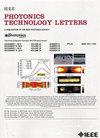Optical Funnel Effect of Fiber-End Conical Shell Light Field
IF 2.3
3区 工程技术
Q2 ENGINEERING, ELECTRICAL & ELECTRONIC
引用次数: 0
Abstract
The manipulation and analysis of particles in fluid has always been a matter of concern. In the liquid microfluidic system, the quality of single cell flow directly affects the final analysis results. Due to its special structure, optical fiber has the advantages of simple structure and good compatibility and has become a cross-integration link in various research fields. In this letter, an integrated optical fiber structure for particle manipulation in fluid is proposed. The annular-core capillary fiber developed by the laboratory is adopted, which has the structure of cladding - annular core - air hole. The cone angle of 12° is polished at the exit end of the optical fiber. The laser transmitted by the annular core is reflected by the cone and forms a funnel-shaped cone shell light field at the end of the optical fiber, which is called ‘optical funnel’. When the particles are injected from the air hole and pass through the conical shell light field, the continuous directional control is formed due to the action of the light field force. The device has the characteristics of simple structure and high integration, which provides a solution for the miniaturization of instruments and equipment and is of great significance in engineering applications.光纤端锥形外壳光场的光漏斗效应
流体中粒子的处理和分析一直是人们关注的问题。在液体微流控系统中,单细胞流动的质量直接影响最终的分析结果。光纤由于其特殊的结构,具有结构简单、兼容性好等优点,已成为各个研究领域交叉集成的环节。本文提出了一种用于流体中粒子操纵的集成光纤结构。采用实验室研制的环芯毛细管光纤,其结构为包层-环芯-空穴。在光纤的出口端抛光12°的锥角。通过环形芯传输的激光被锥反射,在光纤的末端形成一个漏斗状的锥壳光场,称为“光漏斗”。当粒子从气孔注入并穿过锥形壳光场时,由于光场力的作用,形成连续的定向控制。该装置具有结构简单、集成度高的特点,为仪器设备的小型化提供了解决方案,在工程应用中具有重要意义。
本文章由计算机程序翻译,如有差异,请以英文原文为准。
求助全文
约1分钟内获得全文
求助全文
来源期刊

IEEE Photonics Technology Letters
工程技术-工程:电子与电气
CiteScore
5.00
自引率
3.80%
发文量
404
审稿时长
2.0 months
期刊介绍:
IEEE Photonics Technology Letters addresses all aspects of the IEEE Photonics Society Constitutional Field of Interest with emphasis on photonic/lightwave components and applications, laser physics and systems and laser/electro-optics technology. Examples of subject areas for the above areas of concentration are integrated optic and optoelectronic devices, high-power laser arrays (e.g. diode, CO2), free electron lasers, solid, state lasers, laser materials'' interactions and femtosecond laser techniques. The letters journal publishes engineering, applied physics and physics oriented papers. Emphasis is on rapid publication of timely manuscripts. A goal is to provide a focal point of quality engineering-oriented papers in the electro-optics field not found in other rapid-publication journals.
 求助内容:
求助内容: 应助结果提醒方式:
应助结果提醒方式:


